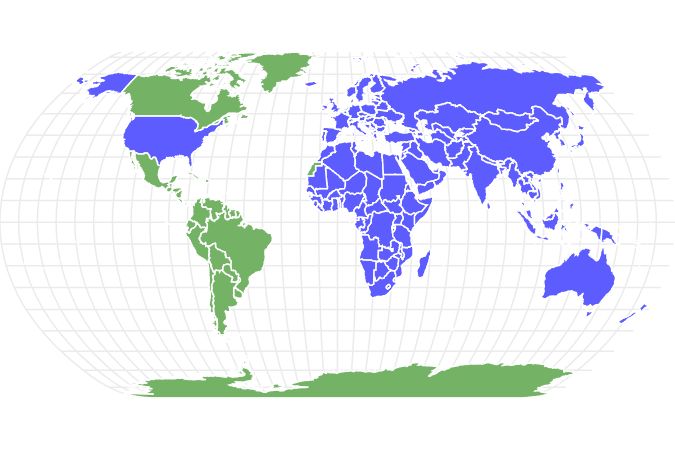Water Buffalo
Bubalus bubalis
Has been domesticated for thousands of years!
Advertisement
Water Buffalo Scientific Classification
- Kingdom
- Animalia
- Phylum
- Chordata
- Class
- Mammalia
- Order
- Artiodactyla
- Family
- Bovidae
- Genus
- Bubalus
- Scientific Name
- Bubalus bubalis
Read our Complete Guide to Classification of Animals.
Water Buffalo Conservation Status
Water Buffalo Facts
View all of the Water Buffalo images!
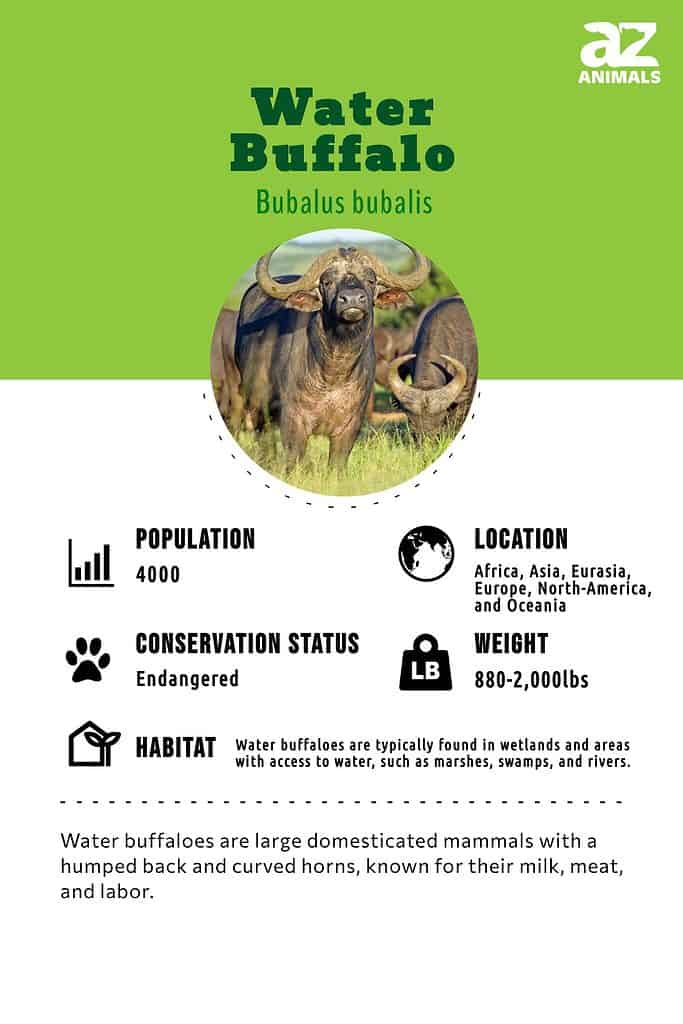
“The water buffalo is known as the living tractor of the East.”
The water buffalo, also known as the Asian buffalo, Asiatic water buffalo, or arni, is the second largest member of the bovid family, and it is closely related to yak, bison, African buffalo, ox, and various other forms of wild cattle.
Its great strength and high-fat content milk have led to its domestication throughout the world, and this, in combination with ritual hunting, has sadly caused the wild water buffalo to become endangered.
Wildlife preserves in Southeast Asia are the last refuge for wild herds, and the population is believed to be in decline.
Incredible Water Buffalo Facts!
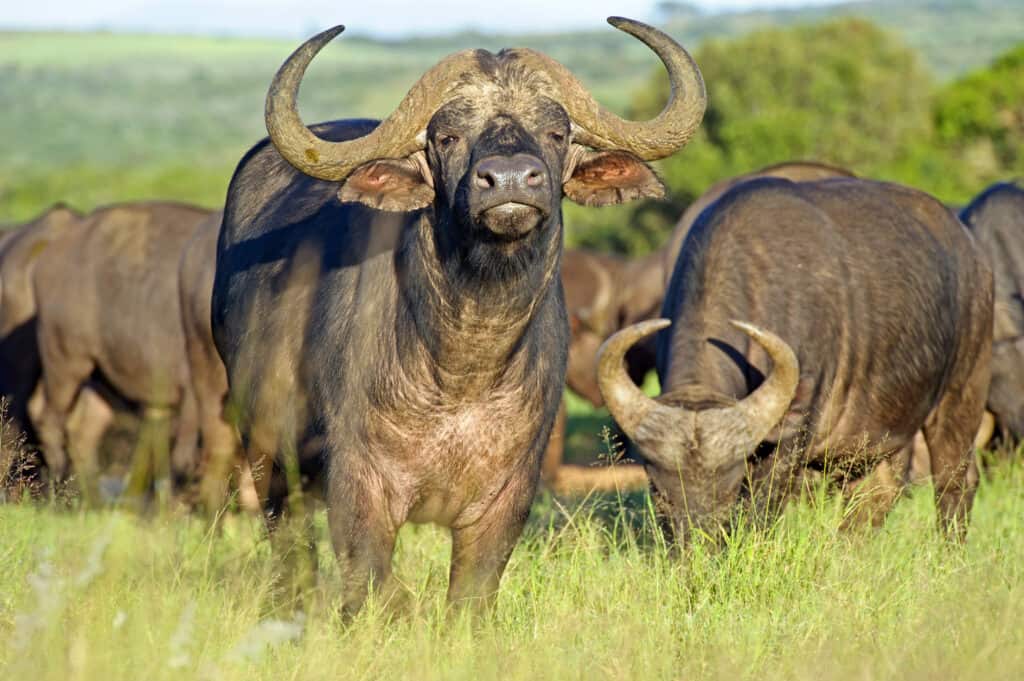
Even apex predators like lions can’t overpower an entire buffalo herd.
©Peter Betts/Shutterstock.com
- While the domestic water buffalo is an extremely common animal, its wild ancestor is endangered with an estimated population of less than 4,000, only 2,500 of which are adults.
- The two major subspecies of these buffalos were actually domesticated for different reasons; river water buffalo were domesticated for their milk, and the swamp water buffalo was domesticated as a draft animal for its strength.
- The largest recorded horn length of a wild water buffalo is 13 feet and 10 inches, longer than a Volkswagen Beetle!
- These buffalos spend almost the entire day submerged in water up to their nostrils or wallowing in the mud like a pig.
- The arni’s fetlock, a joint just above the ankle, is extremely flexible; this unique adaptation allows the arni to freely move about in the thick, deep mud of river and swamp bottoms.
Check out more incredible facts about water buffaloes.
Scientific Name
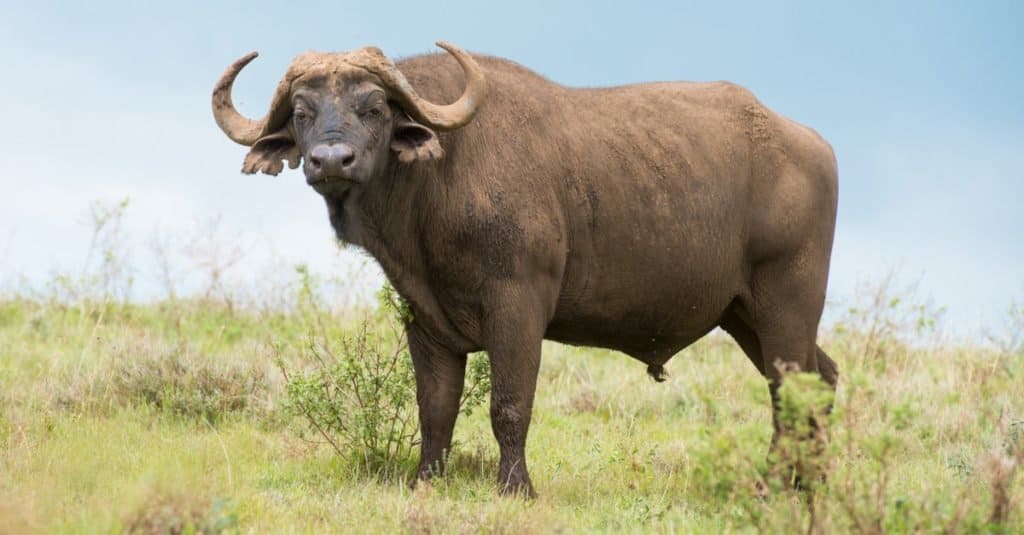
A single African buffalo on African Serengeti. Buffaloes are ferocious and are known to kill lions.
©BonnieBC/Shutterstock.com
These buffalos are closely related to yak, bison, African buffalo, and several other types of wild bovid. The scientific name for the domestic water buffalo is Bubalus bubalis, and the scientific name of their wild counterpart is Bubalus arnee.
There are two subspecies within these buffalos, river, and swamp, which have both been domesticated for different reasons. The Asiatic water buffalo is a close cousin of the African Cape buffalo. The term Bubalus is simply Latin for wild ox or antelope.
List of Water Buffalo Species:
- Murrah buffalo
- Nili-Ravi
- Carabao
- Italian Mediterranean
- Surti buffalo
- Nagpuri
Evolution and Origins
Water buffaloes, or Bubalus bubalis, are large domesticated mammals belonging to the Bovidae family. They are widely distributed throughout the world, particularly in Asia and Africa, and are known for their milk, meat, and labor. While water buffaloes are now a common sight in many parts of the world, their evolution and origins are still an area of much interest and study.
The earliest known ancestor of the water buffalo is the Anoa, a small buffalo-like animal that lived in Indonesia more than two million years ago. Over time, the Anoa evolved into two distinct species: the Swamp buffalo, which is found in Southeast Asia, and the River buffalo, which is found in South Asia.
The Swamp buffalo is thought to have originated in the region of the Brahmaputra River in present-day Bangladesh and eastern India. From there, it spread across Southeast Asia, where it became an important animal for agriculture and transportation. The River buffalo, on the other hand, is believed to have originated in the region of the Ganges River in northern India. It was later introduced to other parts of the world, such as the Middle East, Africa, and Europe.
The domestication of the water buffalo is believed to have started more than 5,000 years ago in the Indus Valley civilization, which spanned parts of present-day Pakistan and India. Archaeological evidence, such as terracotta figurines and seal impressions, suggests that water buffaloes were an important part of the agricultural system of the Indus Valley people. They were used for plowing fields, pulling carts, and as a source of milk and meat.
Appearance and Behavior
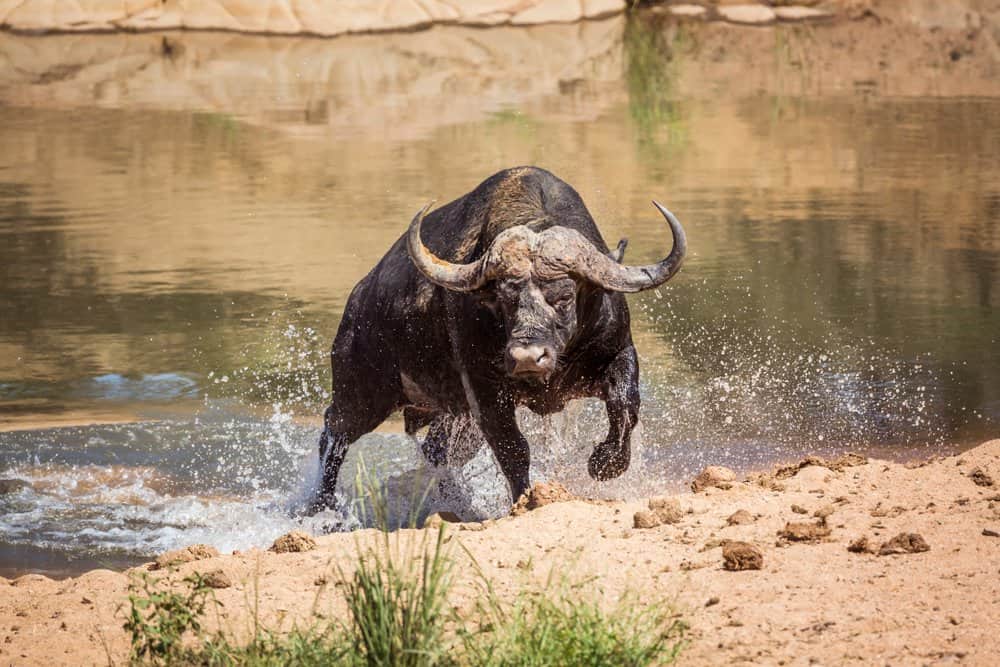
The wild arni is a gigantic animal. It is nearly 10 feet long and measures almost six feet at the shoulder.
©PACO COMO/Shutterstock.com
The wild arni is a gigantic animal. It is nearly 10 feet long and measures almost six feet at the shoulder. They are primarily dark gray or black in color and have massive backward curving horns. Males are larger, typically weighing in at around 2,600 pounds, with full-sized horns while females have proportionately smaller horns. The males weigh about the same as two-and-a-half grizzly bears!
The average length of a male’s horns is approximately five feet, but the longest recorded horn length is a staggered 13 feet 10 inches. In comparison, a Volkswagen Beetle is only 13 feet and 5 inches.
The domestic buffalos can range anywhere from just under 1,000 pounds upwards to 2,000 pounds. Coloration remains primarily the same, but horn shape and size can vary significantly over some of the 74 different breeds of these domesticated buffalos.
These buffalo spend most of the day submerged, sometimes up to their nostrils, in the water of rivers or swamps. This serves two major purposes. First, these buffalo do not possess adequate sweat glands to keep themselves cool through sweat evaporation along, so remaining submerged allows them to regulate their temperature in the hot, humid Southeast Asia climate.
Secondly, the water protects the buffalos from all manners of biting insects that also inhabit the jungle. To help provide extra insect protection, water buffalo use their horns to dig up bottom mud from the river or swamp and throw it onto themselves in a process called wallowing.
These buffalos generally travel in groups called a herd. The herd consists of around five to eight adult females, called cows, and their respective calves. The herd may or may not have a male, or bull, accompanying them.
Young bulls travel in all-male groups of similar age called bachelor herds, but older bulls will travel alone. Herds of 30 to 40 buffalo are not uncommon, but it is difficult to differentiate between domestic, feral, and wild water buffalo because of free-range farming common in the region.
Habitat
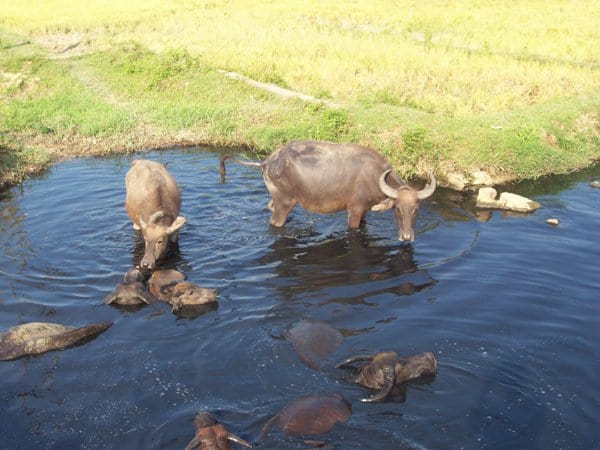
Domestic water buffalo are animals that are found in Europe, Asia, Africa, Japan, Hawaii, and North and South America.
Domestic water buffalo are animals that are found in Europe, Asia, Africa, Japan, Hawaii, and North and South America. Wild buffalos, however, only remain in small, protected areas of Southeast Asia in India, Nepal, Thailand, and Bhutan. It should be noted that the current habitat of these buffalos is not indicative of their true preference. Over-hunting has led to their survival only in remote, difficult-to-access, or preserved areas.
Thick jungle or swampland provides adequate cover and water for the buffalo as well as enough vegetation for dietary purposes. These buffalo almost migrate as the weather seasons shift. The rainy season allows for more movement as water becomes more prevalent.
Diet
These buffalos are herbivores and forage for their food. They prefer grasses, but will also eat fruit, shrubs, bark, and other foliage. Buffalo, in areas that are free from human contact, will feed in the open at dawn and dusk while remaining concealed during the hottest parts of the day.
Feral buffalo, and those without adequate protection from the sun, will graze sporadically. This is likely due to the influence of inter-breeding with their domestic counterparts, and it also shows in their more cattle-like behavior as opposed to their purely wild cousins.
Predators and Threats
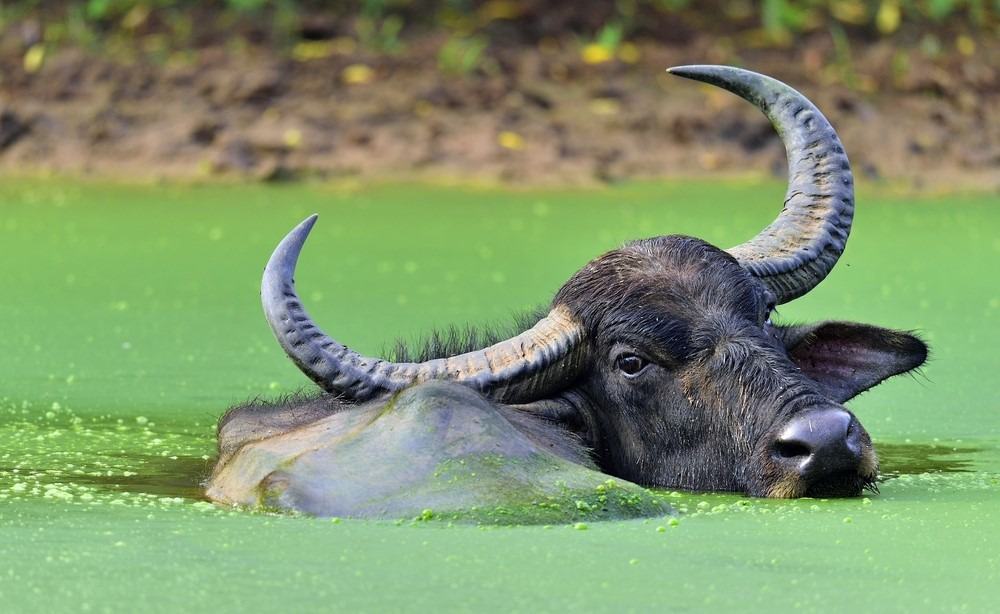
The two primary threats to the arni are humans and domestic buffalo. Humans hunt buffalos for meat, their horns, and for ritualistic purposes as well
©Sergey Uryadnikov/Shutterstock.com
The two primary threats to the arni are humans and domestic buffalo. Humans hunt buffalos for meat, their horns, and for ritualistic purposes as well. Additionally, habitat loss, driven by the clearing of forests for farmland or residential use, is also human-caused.
Interbreeding with the various types of domesticated buffalo and cattle has resulted in a loss of the genetic identity of the wild water buffalo. This same close contact with domestic breeds exposes the buffalos to disease that has also devastated the wild herds.
The main predators of these buffalos are humans, tigers, leopards, and crocodiles. Almost all of these hunters attack through ambush as these buffalos can be extremely aggressive and dangerous when threatened.
Reproduction, Babies, and Lifespan
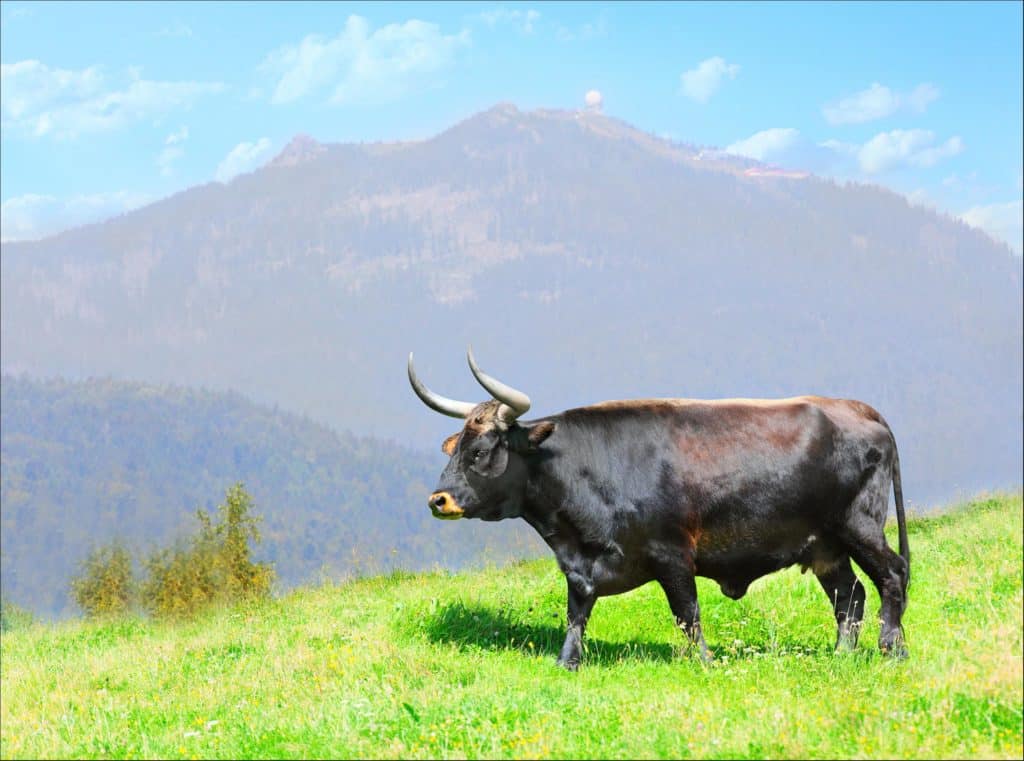
Wild buffalos have an average lifespan of 25 years, while domestic buffalos can live as long as 40 years.
©Kletr/Shutterstock.com
Female water buffalo typically give birth every other year to a single baby called a calf. Male bachelor herds or lone older bulls travel to find accepting mates among the maternal herds. The gestational period lasts 10 or 11 months, and male offspring will remain with the herd for three years while females generally stay for life.
Wild buffalos have an average lifespan of 25 years, while domestic buffalos can live as long as 40 years.
Population
While domesticated buffalos, and their associated hybrid species, account for approximately 165 million individuals, the true population size of the arni is unknown. Their remote, difficult-to-access habitat and the difficulty in noting the difference between domestic, feral, and wild herds have all been significant challenges to the study of the species.
Researchers estimate that approximately 4,000 wild water buffalo remain free and fewer than 2,500 of those are mature adults. This population is believed to be in decline as the low number of wild herds continue to interbreed with domestic, feral, and hybrid water buffalo.
The wild buffalos, Bubalus, are endangered, and it exists almost exclusively in protected preserves in Southeast Asia. These preserves are the only effective conservation effort that is being attempted to keep wild herds genetically pure.
Zoo
Arnis are fairly common sights in zoos in the United States. Even smaller zoo and rescue facilities like the Little Ponderosa Zoo in Clinton, TN have arni on site. Six Flags Great Adventure in Jackson, NJ even offers a drive-thru safari attraction that boasts Asiatic water buffalo.
View all 108 animals that start with WWater Buffalo FAQs (Frequently Asked Questions)
Why is it called a water buffalo?
Water buffalo earned their name due to the fact that they spend the vast majority of their day submerged in water. In fact, their hooves developed as widely splayed in order to prevent them from sinking into the thick mud of swamps and river bottoms.
Are water buffalos dangerous?
The short answer is, “It depends.” Typically, water buffalo avoid human contact and prefer to be left alone. However, when threatened, the entire herd will advance directly toward the threat with their horns lowered. Due to their massive size and strength, water buffalos can easily kill a human, and they present enough of a threat to their predators that almost all of them hunt via ambush exclusively. Water buffalo are significantly less aggressive than the African Cape buffalo who is responsible for an average of 200 human deaths per year.
What is the difference between a water buffalo and a buffalo?
The major difference between water buffalo and buffalo is very similar to the old square versus rectangle adage. All water buffalo are buffalo, but not all buffalo are water buffalo. The term buffalo has been used colloquially to refer to animals as far removed from the water buffalo as the American bison.
Water buffalo are unique in that they spend the majority of their time submerged in water or wallowing in mud. Most other buffalo species have a hump located between their shoulders while a distinctive sign of the Asian water buffalo is a flat back.
What do water buffalo eat?
Water buffalo eat grass, herbs, shrubs, tree bark, and other available greens. They are exclusively herbivores.
What is a water buffalo?
A water buffalo is a large bovid native to remote areas of Southeast Asia. They have been widely domesticated; however, the wild water buffalo is endangered with fewer than 4,000 truly wild animals left.
What Kingdom do Water Buffalo belong to?
Water Buffalo belong to the Kingdom Animalia.
What phylum do Water Buffalo belong to?
Water Buffalo belong to the phylum Chordata.
What class do Water Buffalo belong to?
Water Buffalo belong to the class Mammalia.
What family do Water Buffalo belong to?
Water Buffalo belong to the family Bovidae.
What order do Water Buffalo belong to?
Water Buffalo belong to the order Artiodactyla.
What genus do Water Buffalo belong to?
Water Buffalo belong to the genus Bubalus.
What type of covering do Water Buffalo have?
Water Buffalo are covered in Leathery skin.
In what type of habitat do Water Buffalo live?
Water Buffalo live in marshes and swamplands.
What are some predators of Water Buffalo?
Predators of Water Buffalo include humans, wild cats, and crocodiles.
How many babies do Water Buffalo have?
The average number of babies a Water Buffalo has is 1.
What is an interesting fact about Water Buffalo?
The Water Buffalo has been domesticated for thousands of years!
What is the scientific name for the Water Buffalo?
The scientific name for the Water Buffalo is Bubalus bubalis.
What is the lifespan of a Water Buffalo?
Water Buffalo can live for 15 to 25 years.
How fast is a Water Buffalo?
A Water Buffalo can travel at speeds of up to 30 miles per hour.
What is the difference between a cape buffalo and a water buffalo?
The most profound differences between a cape buffalo and a water buffalo include the area of the world they inhabit, their size, and their domestication.
Thank you for reading! Have some feedback for us? Contact the AZ Animals editorial team.
Sources
- David Burnie, Dorling Kindersley (2011) Animal, The Definitive Visual Guide To The World's Wildlife / Accessed December 5, 2008
- Tom Jackson, Lorenz Books (2007) The World Encyclopedia Of Animals / Accessed December 5, 2008
- David Burnie, Kingfisher (2011) The Kingfisher Animal Encyclopedia / Accessed December 5, 2008
- Richard Mackay, University of California Press (2009) The Atlas Of Endangered Species / Accessed December 5, 2008
- David Burnie, Dorling Kindersley (2008) Illustrated Encyclopedia Of Animals / Accessed December 5, 2008
- Dorling Kindersley (2006) Dorling Kindersley Encyclopedia Of Animals / Accessed December 5, 2008
- David W. Macdonald, Oxford University Press (2010) The Encyclopedia Of Mammals / Accessed December 5, 2008
- Britannica / Accessed October 13, 2020
- National Geographic / Accessed October 13, 2020
- IUCN Red List / Accessed October 13, 2020

